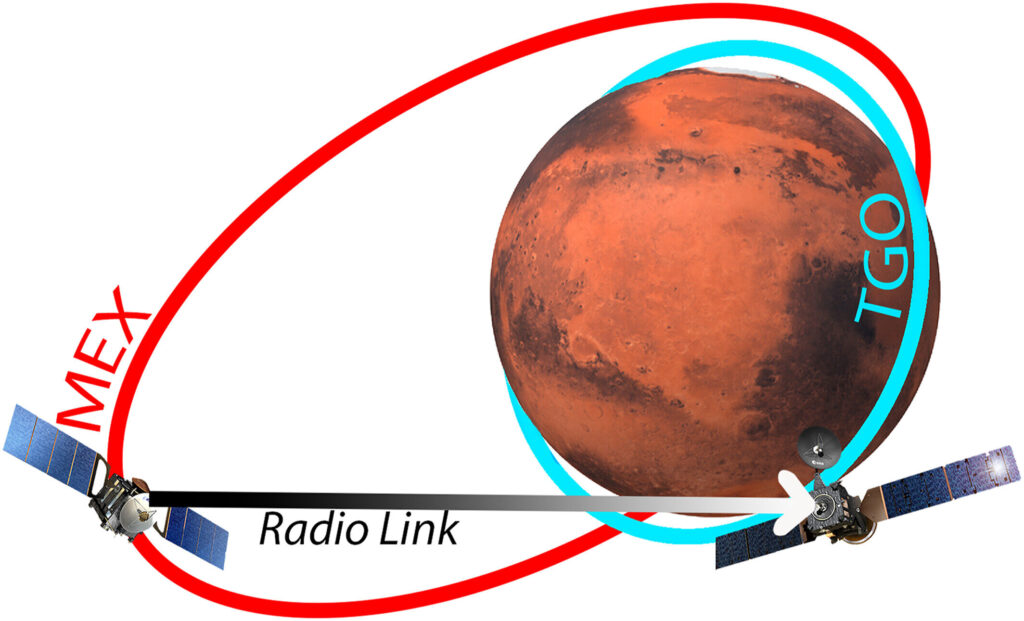Scientists have deployed two probes in Mars orbit using the radio occultation technique, which measures signals from the craft as it hides behind the planet. This allowed them to learn more about previously inaccessible parts of its atmosphere.

Martian atmosphere and radio signals
Using the modified equipment, a team of researchers from Imperial College London measured parts of the Martian atmosphere that were previously impossible to study. This includes areas that could block radio signals if not properly accounted for. This is crucial for future Mars settlement missions.
The results of the first 83 measurements, analyzed by researchers from Imperial College London and European Space Agency colleagues from across Europe, are published today in the journal Radio Science.
For this purpose, the ExoMars Trace Gas Orbiter (TGO) teamed up with another ESA spacecraft orbiting the Red Planet, the Mars Express (MEX). Both spacecraft maintain radio communications, so when one of them passes behind the planet, radio waves penetrate deeper layers of the Martian atmosphere.
Changes in the refraction of the atmosphere cause tiny but noticeable shifts in the radio frequencies received by the spacecraft. By analyzing these shifts, scientists can determine the density of the lower atmosphere and the density of electrons in the ionosphere, the charged upper layer of the gas envelope. This method is called mutual radio occultation.
Joint operation of the devices
Previously, radio occultation was carried out using radio communications between an orbiter on Mars and large ground stations on Earth. The radio signal from the orbiter was tracked when the spacecraft was “setting” (behind Mars), i.e., the signal passed through the layers of the planet’s atmosphere.
Using two orbiters to make this measurement is already a standard way to study the Earth’s atmosphere: thousands of such measurements take place between global navigation satellites, where the data they provide is used to monitor the atmosphere and forecast weather.
However, NASA has used this method on Mars only three times before: in 2007 as a hardware demonstration. The new use of the two ESA spacecraft marks the first time this technique has been used regularly on another planet. Now that its viability has been proven, the scientists and engineers behind this work are looking for ways to expand the use of this technology in future missions to Mars.
Study co-author Dr. Colin Wilson, a researcher at the agency’s ExoMars Trace Gas Orbiter and Mars Express projects, said: “ESA has demonstrated the viability of this method, which could be transformative for Mars science in the future. There are currently seven spacecraft orbiting Mars; as the number of spacecraft increases, as it will in the coming decades, the number of opportunities for radio occultation is growing rapidly. Therefore, this method will be an increasingly important tool for studying Mars.”
More measurements, more knowledge
Spacecraft-to-spacecraft radio occultation allows for more measurements and new areas of the atmosphere to be explored.
Since conventional radio occultations on Mars involve radio communication with a ground station, the measurement location is fixed relative to the slow motion of the Earth. This makes it difficult to record global changes on the planet, as researchers often look at the same points. In addition, due to the Earth’s proximity to the Sun, this method allows sampling only during sunset and sunrise, which limits our understanding of its atmosphere.
In addition, traditional radio occultation suffers from “eclipse seasons” when measurements are only possible for a few months each year due to the orbit of the spacecraft. For example, in 2022, Mars Express was only able to conduct radio occultation for two months.
Reciprocal radio occultation overcomes these problems, allowing scientists to explore the entire depth of the Mars ionosphere at midday and midnight for the first time.
Based on materials from phys.org

